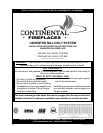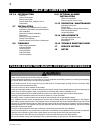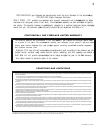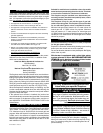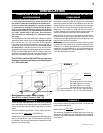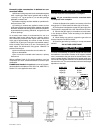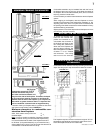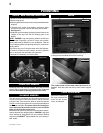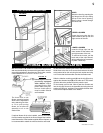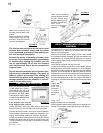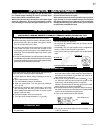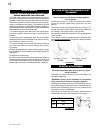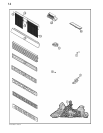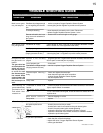
5
W415-0298 / K / 12.06.07
ROOM 2
ROOM 1
This heater shall not be installed in a confined space
or unusually tight construction unless provisions are
provided for adequate combustion and ventilation air.
In order to avoid the possibility of exposed insulation
or vapour barrier coming in contact with the fireplace
body, it is recommended that the walls of the fireplace
enclosure be ‘finished’, (i.e. drywall/sheetrock) as would
any other outside wall of the home. This will ensure
that clearance to combustibles is maintained within
the cavity.
The National Fuel Gas Code, ANSI Z223.1 defi nes a confi ned
space as a space whose volume is less than 50 cubic feet
per 1,000 Btu per hour (4.8 m
3
per kW) of the aggregate
input rating of all appliances installed in that space and an
unconfi ned space as a space whose volume is not less than
50 cubic feet per 1,000 Btu per hour (4.8 m
3
per kW) of the
aggregate input rating of all appliances installed in that space.
Rooms communicating directly with the space in which the
appliances are installed, through openings not furnished with
doors are considered a part of the unconfi ned space.
The CVF36 is rated at 30,000BTUs per hour and
therefore requires a minimum unconfined space
of 1,500 cubic feet.
To determine the volume of the room where the heater is to
be installed, multiply the width x the length x the ceiling height
of that room measured in feet. If any adjoining rooms are con-
nected by grills or openings such as kitchen pass-throughs,
etc., the volume of those rooms may be added to the total.
Multiply the room volume by 1000 and divide this amount
by 50 to determine the maximum Btu/hr that the space can
support with adequate combustion and ventilation air.
Add the Btu/hr of all fuel burning appliances located within
the space such as gas furnace, gas water heater, etc. Do not
include direct vent gas appliances which draw their input and
output air from and to the outdoors.
WARNING: If the area in which the heater may be operated
is smaller than that defi ned as an unconfi ned space or if the
building is of unusually tight construction, provide adequate
combustion and ventilation air by one of the methods de-
scribed in the National Fuel Gas Code ANSI Z223.1, Section
5.3 or the applicable local code.
FIGURE 1
Room Volume = Length x Width x Height
Max BTU/hr = Room Volume x 1000 ÷ 50
If for example,
the length of the rooms is 10 feet,
the width of Room 1 is 10 feet,
the width of Room 2 is 15 feet
the height of the rooms is 8 feet.
The volume of Room 1: 10 x 10 x 8 = 800 cubic feet.
The volume of Room 2: 10 x 15 x 8 = 1200 cubic feet.
If in this example a solid door separates Room 1 from Room
2, the volume of Room 2 could not be used. In this case the
maximum BTU/h would be:
Maximum BTU/h:
800 x 1000
= 16,000 BTU/h
This would be considered a confi ned space since it can not
support the 30,000BTU/h input of the heater and it would be
necessary to provide adequate combustion and ventilation
air to Room 1.
In this example, because there is no door to the adjoining
room, the volume of the adjoining room may be added to the
volume of the room with the heater to get a total unconfi ned
space.
The total unconfi ned space: 800 + 1200 = 2000 cubic feet.
Maximum BTU/h:
2000 x 1000
= 40,000 BTU/h
If there are no more fuel burning appliances within this space
then the 30,000 BTU/h input of the fi replace is suitable to
be installed. This also assumes that the construction of this
space is not unusually tight.
HEIGHT
WIDTH
LENGTH
50
50
INSTALLATION
COMBUSTION & VENTILATION
AIR PROVISIONS
DETERMINING CONFINED OR UNCON-
FINED SPACE
EXAMPLE 1 EXAMPLE 2



